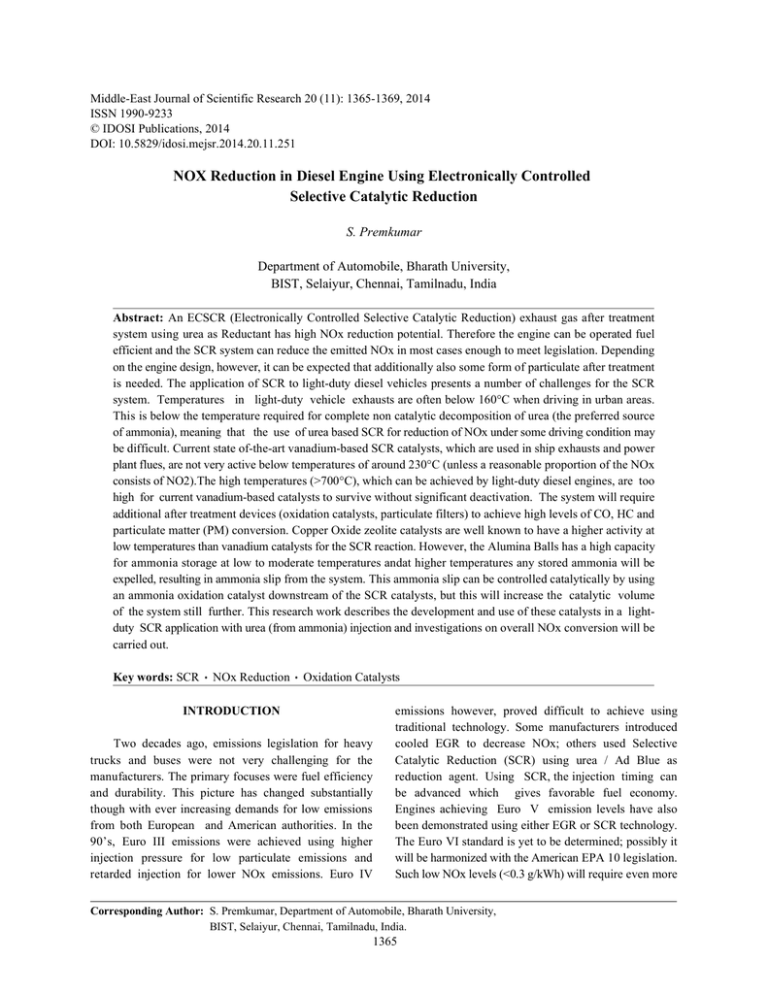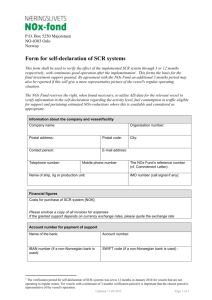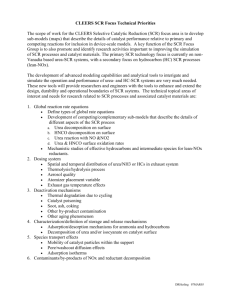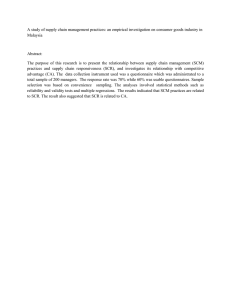Full Text
advertisement

Middle-East Journal of Scientific Research 20 (11): 1365-1369, 2014 ISSN 1990-9233 © IDOSI Publications, 2014 DOI: 10.5829/idosi.mejsr.2014.20.11.251 NOX Reduction in Diesel Engine Using Electronically Controlled Selective Catalytic Reduction S. Premkumar Department of Automobile, Bharath University, BIST, Selaiyur, Chennai, Tamilnadu, India Abstract: An ECSCR (Electronically Controlled Selective Catalytic Reduction) exhaust gas after treatment system using urea as Reductant has high NOx reduction potential. Therefore the engine can be operated fuel efficient and the SCR system can reduce the emitted NOx in most cases enough to meet legislation. Depending on the engine design, however, it can be expected that additionally also some form of particulate after treatment is needed. The application of SCR to light-duty diesel vehicles presents a number of challenges for the SCR system. Temperatures in light-duty vehicle exhausts are often below 160°C when driving in urban areas. This is below the temperature required for complete non catalytic decomposition of urea (the preferred source of ammonia), meaning that the use of urea based SCR for reduction of NOx under some driving condition may be difficult. Current state of-the-art vanadium-based SCR catalysts, which are used in ship exhausts and power plant flues, are not very active below temperatures of around 230°C (unless a reasonable proportion of the NOx consists of NO2).The high temperatures (>700°C), which can be achieved by light-duty diesel engines, are too high for current vanadium-based catalysts to survive without significant deactivation. The system will require additional after treatment devices (oxidation catalysts, particulate filters) to achieve high levels of CO, HC and particulate matter (PM) conversion. Copper Oxide zeolite catalysts are well known to have a higher activity at low temperatures than vanadium catalysts for the SCR reaction. However, the Alumina Balls has a high capacity for ammonia storage at low to moderate temperatures andat higher temperatures any stored ammonia will be expelled, resulting in ammonia slip from the system. This ammonia slip can be controlled catalytically by using an ammonia oxidation catalyst downstream of the SCR catalysts, but this will increase the catalytic volume of the system still further. This research work describes the development and use of these catalysts in a lightduty SCR application with urea (from ammonia) injection and investigations on overall NOx conversion will be carried out. Key words: SCR NOx Reduction Oxidation Catalysts INTRODUCTION Two decades ago, emissions legislation for heavy trucks and buses were not very challenging for the manufacturers. The primary focuses were fuel efficiency and durability. This picture has changed substantially though with ever increasing demands for low emissions from both European and American authorities. In the 90’s, Euro III emissions were achieved using higher injection pressure for low particulate emissions and retarded injection for lower NOx emissions. Euro IV emissions however, proved difficult to achieve using traditional technology. Some manufacturers introduced cooled EGR to decrease NOx; others used Selective Catalytic Reduction (SCR) using urea / Ad Blue as reduction agent. Using SCR, the injection timing can be advanced which gives favorable fuel economy. Engines achieving Euro V emission levels have also been demonstrated using either EGR or SCR technology. The Euro VI standard is yet to be determined; possibly it will be harmonized with the American EPA 10 legislation. Such low NOx levels (<0.3 g/kWh) will require even more Corresponding Author: S. Premkumar, Department of Automobile, Bharath University, BIST, Selaiyur, Chennai, Tamilnadu, India. 1365 Middle-East J. Sci. Res., 20 (11): 1365-1369, 2014 advanced engine technology and more optimization work. Hydrocarbon (HC) and carbon monoxide (CO) are also regulated, although these emission levels are generally not difficult to achieve in diesel engines due to the high air-fuel ratio. 00, 050, 10, 150, 20,250,3012345678NOx [g/kWh] PM [g/kWh] Euro II 1996Euro III 2000Euro IV2005Euro V2008EPA 10 2010 CO2 emissions are currently not regulated by legislation. In the near future it is likely that such legislation will come into effect, or possibly taxation which will increase the demand for fuel efficient engines with correspondingly low CO2 emissions. Fuel efficiency has always been an important factor for heavy truck customers; despite this the current engines have poorer efficiency than a decade ago because of the stringent Nox/PM legislation. The trade-off between low emissions and fuel efficiency will be an even more important challenge in the close future for diesel engine developers [1-4]. Objective: This work intends to develop models for engine-out emissions (Nox primarily) and SCR catalyst models. The models should be of such low complexity that they can be used for optimization and control purposes while maintaining good agreement with measurements [5]. NOX Formation: NOx-Nitric Oxide (NO) or Nitrogen dioxide (NO2) a Pollutant and the product of combustion process. The Nox reduction reaction takes place as the gases pass through the catalyst chamber [6]. Before entering the catalyst chamber the ammonia, or other Reductant (Urea), is injected and mixed with the gases. The chemical equation for a stoichiometric reaction using either anhydrous or aqueous ammonia for a selective catalytic reduction process is as follows: 4NO2+4NH3+O2 2NO2+4NH3+O2 NO+NO2+2NH3 4N2+6H2O 3N2+6H2O 2N2+3H2O With Several Secondary reactions 2SO2+O2 2SO3 2NH3+SO3+H2O (NH4)2SO4 NH3+SO3+H2O NH4HSO4 The reaction of urea instead of either anhydrous or aqueous ammonia is follows. 4NO+2(NH2)2CO+O2 4N2+4H2O+2CO2 Nitrogen oxides (Nox) are pollutants harmful both to the environment and human health. When NOx reacts with volatile organic compounds (VOCs), ground level ozone is formed which again contributes to smog. Ozone causes a range of health problems ranging from respiratory illnesses to premature mortality. NOx is also a major contributor to acid rain. Selective Catalytic Reduction: A Selective catalytic reduction (SCR) technology is the most cost effective method to reduce NOx emissions and reduce our environmental imprint SCR works by injecting a very precise amount of automotive grade urea/water solution called diesel exhaust fluid into vehicles exhaust gas stream. Under the heat of vehicles exhaust, the urea in the DEF is converted into ammonia gas and carbon dioxide. Once inside the SCR catalyst, this ammonia gas forms a chemical reaction with oxides of nitrogen (NOx) emitted by the engine. As a result of this chemical reaction, SCR is able to reduce the harmful oxides of nitrogen into harmless water vapor and nitrogen gas-natural elements common to air we breathe [7-10]. An aqueous urea solution is injected in the exhaust air stream, where it evaporates into ammonia; mixers are utilized after the injection to insure an even blend. Once the exhaust gas and ammonia mixture hits the SCR catalyst surface, a reduction reaction occurs, breaking down the NOx (NO or NO2) and NH3 into N 2 and H 2O NO2 + NH4 N2+2H20 Any ammonia slip is reduced by using an oxidation catalyst, which produce NO or N2 respectively. The result after the reduction is nitrogen and water only. Unfortunately, it is not possible to reach 100 % NOx reduction, especially not during transient conditions. One of the key factors for achieving high conversion is temperature. The SCR catalyst has a temperature window with a lower limit of approximately 200°C and a higher limit of around 450-500°C. Outside this window, the reduction capability of the catalyst is severely decreased. The catalyst also has much slower dynamics compared to the engine; the catalyst typically requires several minutes 1366 Middle-East J. Sci. Res., 20 (11): 1365-1369, 2014 Appearance: White crystalline granules or powder before reaching chemical equilibrium compared to a few milliseconds for the diesel engine. It is also important to have proper control of the urea dosing to avoid ammonia slip, i.e. ammonia in the exhaust gas after the catalyst. Ammonia has a distinct unpleasant smell and is also regulated by legislation. A urea-SCR system consists of three major building blocks: Table: 2.3.1 Alumina Balls Chemical Formula Bulk Specific Gravity Apparent Porosity Water Absorption Melting Temperature Refractive Index Hardness Chemical Purity Chemical Inertness Urea dosing system Control system SCR catalyst AL2O3 3.55 4.0% 1.0% 2040°C(3704°F) 1.76 9 99.5% AL2O3 Resistant to most alkalis and mineral acids Cobalt Nitrate: In this experiment Cobalt Nitrate has used as a catalyst Material inside the Selective catalytic reduction Unit. The urea is injected into the exhaust stream from the urea dosing system. The injection point should preferably be some distance before the catalyst to ensure proper mixing. The urea is decomposed (thermolyzed) to ammonia and isocyanic acid. The isocyanic acid is further hydrolyzed to ammonia and carbon monoxide. Synonyms: Nitric acid, cobalt (2+), hexahydrate; cobalt dinitrate hexahydrate; Cobalt nitrate hexahydrate. CAS No: 10141-05-6 Hexahydrate) Engine Specification: Anhydrous; (10026-22-9 Molecular Weight: 291.03 No of Cylinder-Single Cylinder Bore, Stroke and CC-114.8 x 139.7mm and 1433 CC Compression Ratio-18:1 Rated Power Output-5.9KW @ 1500rpm Fuel Injection Pressure -180 to 200 bar SFC-268g/KW hr Combustion Peak Pressure-76 bar Combustion Peak Temperature-900 C Fuel Tank Capacity-5 Liters Alumina Balls: In this experiment Alumina balls has used as a ceramic Material inside the Selective catalytic reduction Unit. Alumina balls are high-density, fully shrunk, coarse crystalline alpha alumina that have been converted to the corundum form. Tabular alumina is produced by sintering ball-formed calcined alumina at a temperature just under the 2040°C (3704°F) fusion point of aluminium oxide. These tabular alumina balls are then crushed, graded or screened and ground to a wide range of granular or powdered particle size distributions. The typical chemical and physical properties which characterize tabular alumina are presented in this product data. Some of these properties are highlighted in the following table. Chemical Formula: Co(NO3)2 6H2O Inhalation: Causes irritation to the respiratory tract, symptoms may include coughing, shortness of breath andnausea. Respiratory hypersensitivity, asthma may appear. Inhalation of cobalt dust and fumes is associated with an increased incidence of lung disease. Ingestion: Toxic. Causes abdominal pain, nausea, vomiting, flushing of the face and ears, mild hypotension, rash andringing in the ears. May have cumulative toxic action where elimination cannot keep pace with absorption. Large amounts depress erythrocyte production. Skin Contact: Causes irritation to skin. Symptoms include redness, itching andpain. May cause dermatitis. Eye Contact: Causes irritation, redness andpain. Chronic Exposure: Repeated oral administration may produce goiter and reduced thyroid activity. Prolonged or repeated skin exposure may cause dermatitis. Chronic exposure associated with kidney, heart and lung damage. 1367 Middle-East J. Sci. Res., 20 (11): 1365-1369, 2014 Aggravation of Pre-existing Conditions: Persons with pre-existing skin disorders or eye problems, or impaired liver, kidney or respiratory function may be more susceptible to the effects of the substance. Persons with allergies or sensitivity to cobalt may also be more susceptible to the effects of the substance. Test Results: Table 2: Basic Engine Emission Readings Emission ---------------------------------------------------------------------------Si. No Load (in kg) Time taken for fuel consumption (5 cc seconds) HC in ppm CO in % CO 2 in % Nox in ppm 1 0 30.53 1480 0.06 2.5 70 2 5 30.01 1381 0.06 2.6 68 3 10 22.63 1414 0.07 3.1 108 4 15 21.52 1458 0.07 3.2 118 5 20 16.62 1525 0.08 4.3 223 Table 3:Engine Emission Readings (With SCR) Emission ---------------------------------------------------------------------------Si. No Load (in kg) Time taken for fuel consumption (5 cc seconds) CO in % CO2 in % Nox in ppm 1 0 30.8 1480 0.04 2.3 37 2 5 30 1381 0.04 2.5 46 3 10 21.8 1418 0.03 3.2 78 4 15 20.5 1459 0.03 3.4 114 5 20 16.6 1518 0.02 4.1 206 1368 HC in ppm Middle-East J. Sci. Res., 20 (11): 1365-1369, 2014 CONCLUSION 2. An effective catalyst or catalyst system for treatment of exhaust gases in a lean environment, whether it is diesel or gasoline based, must be able to convert NOx species to N2. The results presented in this work clearly indicate that an Ag HC-SCR catalyst has the ability to reduce NOx to N2 and NH3 (21). Importantly, this activity occurs over a wide temperature range and includes temperatures down to 150 co which represent startup and warm-up components of test cycles. At lower space velocities, such as 25,000 h-1 and in the presence of H2, we have shown a maximum activity of about 75% conversion to N2 is achieved at 200°C. This activity is observed to be both sustainable and repeatable over many tests and regeneration cycles. The data indicates that relatively low concentrations of reactive HCs such as Iso-octane and dodecane are needed to reduce NOx to N2 and NH3. This is important because it suggests that onboard fuels are the only Reductant necessary. Nox Reduction in Diesel Engine Using Selective Catalytic Reduction unit has been installed and tested successfully at madras institute of technology Engine Testing lab and it has proven that using that system NOx can be reduce up to 21.2% By using Electronically controlled selective catalytic reduction unit. Evolution of Nox emissions in Europe with focus on road transport control measures-Atmospheric Chemistry and Physics. 3. Selective catalytic reduction for heavy-duty And light-duty vehicles-Association of Emissions controlled by Catalyst AISBL. 4. The Application of Emissions Control Technologies to a Low-Emissions Engine to Evaluate the Capabilities of Future Systems for European and World-Harmonized Regulations-Mr John May, Mr Dirk Bosteels, AECC, Brussels, Belgium & Mr Andrew Nicol, Mr Jon Andersson, Mr Chris Such Ricardo UK Ltd, Shoreham, UK. 5. Engine and Reactor Evaluations of HC-SCR for Diesel NOx Reduction-Richard Blint, Michael B. Viola and Steven J. Schmieg General Motors R&D Center Warren, MI, pp: 48090-9055. 6. Trial Of A New Emissions Control System For Buses In London-Duncan Arrowsmith, Martin Taylor, Ioannis Gekas and Pa Gabrielsson. 7. Selective Catalytic Reduction system-Diesel Technology Forum. 8. Selective Catalytic Reduction-Paccar Engines System. 9. Selective Catalytic Reduction-IZUZU Truck. 10. The Truth about SCR-Green World. REFERENCE 1. Craig, L. DiMaggio, Galen B. Fisher, Ken M. Rahmoeller and Mark Sellnau, 0000. Dual SCR After treatment for Lean NOx Reduction-Delphi Corporation. 1369



